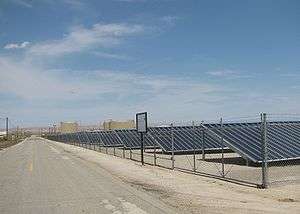Chevron Solarmine
At the time of commissioning in 2003, the 500 kW Chevron Solarmine solar photovoltaic (PV) system was the world's largest thin-film amorphous silicon solar PV system and one of the largest solar PV systems in the United States.[1] Located at the Midway-Sunset Oil Field, Solarmine was the first solar PV system in California to power oil field operations.[1]
| Chevron Solarmine | |
|---|---|
 Chevron Solarmine System | |

| |
| Country | United States |
| Location | Fellows, California |
| Coordinates | 35°11′1.6″N 119°32′22.4″W |
| Status | Operating |
| Owner(s) | Chevron Corporation |
| Operator(s) | Chevron Corporation |
| Solar farm | |
| Type | Flat-panel PV |
| Site area | 6 acres |
| Power generation | |
| Units operational | 500 kW |
| Nameplate capacity | 500 kW AC |
| Annual net output | 900,000 kWh AC |
System
ChevronTexaco and United Solar Systems Corporation (Uni-Solar) collaborated on the design and installation of Solarmine.[1] The building block for the solar PV system is a Uni-Solar PV Laminate (Model PVL-128) that is about 1.3 feet wide by 18 feet long, providing 128 Watts DC.[1][2] The PV laminates are adhered to standing seam metal roof panels which are then attached to ground-mounted metal racks at 20 degree angles.[2] The PV laminates are electrlcally wired in series so that there are twelve 128 Watt PV laminates per string and the overall system has 400 strings, composed of 4,800 PV laminates, for a total of 614 kW DC.[2] The DC power output from the PV laminates is fed into combiner boxes and then two grid-tied inverters, one at 225 kW and the other at 300 kW.[2] The inverter output is fed into three-phase isolation transformers.[2] The PV laminates have good performance in cloudy weather because they are designed to be less dependent on infrared light.[3]

Operations
Solarmine generates about 900,000 kWh AC of electrical energy annually and is used for oilfield operations.[1][4] The operation of the system provided some important insights regarding system design, especially the assumptions used for estimating the system and conversion losses in going from DC to AC, including interconnection (I2R), string mismatch, inverter, soiling, and thermal.[2] The original expected power was 490 kW AC, but the conservative design of the system resulted in regular output in excess of 500 kW AC.[2] A data acquisition system has been collecting data from the site since July 2003 and data analysis has provided quantifications of system performance, as well as the effects of inverter breakdowns and soiling due to the dusty environment.[2] Data analysis for 2008 system operations showed that the annual energy yield was 1653 kWh/kWp, which was aligned with predicted performance using the available solar calculators at the time for thin-film solar PV products.[5]
References
- "ChevronTexaco Installs California's First Solar Project To Power Oil Production | Chevron Corporation". chevroncorp.gcs-web.com. Retrieved 2020-06-13.
- Gregg, A.; Blieden, R.; Chang, A.; Ng, H. (2005). "Performance analysis of large scale, amorphous silicon, photovoltaic power systems". Conference Record of the Thirty-first IEEE Photovoltaic Specialists Conference, 2005. Lake Buena Vista, Florida: IEEE: 1615–1618. doi:10.1109/PVSC.2005.1488454. ISBN 978-0-7803-8707-2.
- Waldner, Erin (February 10, 2006). "Powered by sunshine". The Bakersfield Californian. Retrieved 2020-06-14.
- Campbell, Laura (August 2007). "New Energy Horizons" (PDF). Next* Magazine. 2.
- Yang, Jeffrey; Guha, Subhendu (February 18–19, 2010). "Metastability of Amorphous Silicon Historical Perspective and Real-Life Performance" (PDF). Photovoltaic Module Reliability Workshop 2010, Technical Report NREL/TP-5200-60171, November 2013.